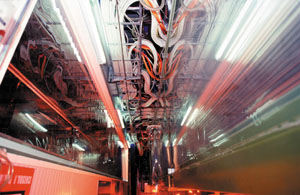Recent experiments at CERN using high-energy beams of nuclei reported evidence for a quark-gluon plasma. Interpreting such evidence is not straightforward, and this article underlines the physics message.


A nucleus is like oranges stacked in a bag – with discernable “fruit” or nucleons (protons and neutrons) and spaces in between. Crush the bag and the oranges dissolve into juice, which fills the reduced space. A pip that once belonged to a particular orange is now free to move anywhere. In the same way, when a nucleus is crushed, it dissolves into a plasma of quarks and gluons. These, once imprisoned inside a particular nucleon, are free to move inside a much larger volume.
In ordinary nuclear matter a nucleus consists of nucleons with a vacuum between them. Each nucleon has a volume of about 2 fm3and contains three valence quarks together with a cloud of gluons – the carriers of the strong nuclear force that binds the quarks in the nucleon and the nucleons in the nucleus.
In physics a phase diagram shows the boundaries between different types of the same substance, such as steam, water and ice, depicting where boiling and freezing occur. Boiling and freezing are very dependent on external conditions, such as pressure and temperature. For nuclear matter the phase diagram shows the boundary between normal nuclear matter, composed of nucleons, and the quark-gluon plasma (QGP).
Normal nuclear matter is situated at temperature zero and a baryochemical potential (a measure of the nucleon density) of about 765 MeV. The nucleon density is about 0.145 fm-3 and the energy density is about 0.135 GeV fm-3.
Compressing nuclear matter, so that the nucleons start to interpenetrate and overlap (by at least 3%), makes the intervening vacuum disappear. Each nucleon dissolves and its constituent quarks and gluons are free to move inside a larger volume, which has become very dense by compression. A new state of matter is now formed – the deconfined QGP – with a critical nucleon density and an energy density of greater than 0.72 fm-3 and 0.7 GeV fm-3 respectively. Liberating quarks at zero temperature therefore requires matter and energy densities at least five times as large as those of normal nuclear matter.
How can this be achieved? The only known way is by compressing and heating nuclear matter, by slamming a very-high-energy beam of nuclei onto fixed-target nuclei, or by bringing two counter-rotating nuclear beams into collision. This was the objective of the heavy-ion fixed-target programme at CERN’s SPS and Brookhaven’s AGS accelerators, and it will also be the aim of the upcoming RHIC and LHC colliders at Brookhaven and CERN respectively.
Theoretical statistical models have been used to analyse and evaluate the data from nucleus-nucleus interactions. Such models produce very satisfactory representation of the experimental data, verifying that the statistical model is applicable. However, little fundamental insight is gained into the actual dynamics of the collision.
The important objective is to ascertain where on the phase diagram the original thermal source (fireball) is situated – in the domain corresponding to a gas of nucleons or in that of the QGP. For this a simple statistical analysis is inadequate. Only if interactions among the multitude of emitted particles are taken into consideration can the description of a possible change of phase into the QGP be envisaged.
Statistical approach
The Statistical Bootstrap Model (SBM), introduced by Rolf Hagedorn at CERN some 35 years ago, is a statistical approach, incorporating at the same time the effects of interactions in a self-consistent way. Recent development and extension of this model, the so-called S (for strangeness) SBM, can define the phase diagram and the limits of nuclear matter, as shown in the diagram (Kapoyannis, Ktorides and Panagiotou, in press). This boundary incorporates the largest possible and physically meaningful value of the critical temperature at zero baryochemical potential (To= 183 MeV) so as to have the largest possible nucleon domain and avoid over-optimistic interpretations.
SSBM-based analysis of data from the NA35 experiment at CERN’s SPS has shown compelling evidence that head-on collisions of even light-nuclei, such as sulphur-32, at 200 GeV/nucleon have attained the critical conditions, thereby allowing us to probe the deconfined quark state.
The overall situation resulting from the data analysis is depicted in the diagram. It is found that the sulphur-sulphur interaction is situated 76% inside the QGP domain, beyond the nucleon phase, while the proton-antiproton collision, measured in the UA5 experiment at CERN, is well within the nucleon region, as expected.
A second indication that the QGP phase has been reached in the sulphur-sulphur collisions is the substantial excess of pion (entropy) production, the explanation for which calls for a contribution of at least 30% from a high-entropy phase, such as that of the QGP.
A third important sign is the achievement of thermal and chemical equilibrium conditions (equilibrium between the different quark species produced) in the initial stage of the nuclear interaction, materializing at a temperature of at least 177 MeV, a baryochemical potential of more than 252 MeV and a strangeness saturation (specifying the relative strange-quark production in chemical equilibrium) of close to unity. Thermal and chemical equilibrium conditions are expected and required for the transition to QGP. Finally, the energy density created in these interactions is at least 2 GeV fm-3– well above the critical value for deconfinement of about 1 GeV fm-3.
These observations, together with several other intriguing clues, give rather definitive indications that the door to the quark-gluon plasma has been opened by the SPS heavy-ion programme at CERN.
Further reading
A S Kapoyannis, C N Ktorides and A D Panagiotou, in press European Physical Journal C(hep-ph/9911306).







